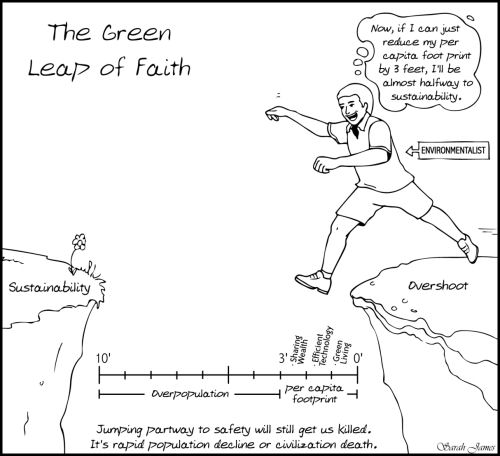The Green Leap Of Faith
 Living smaller can’t offset an unsustainable population that’s growing bigger.
Living smaller can’t offset an unsustainable population that’s growing bigger.

Distractions and Half-Solutions
There are many problems such as climate change, famine, ethnic strife, women’s rights, inaccessible health care and education, which command more attention than the underlying forces which drive them. However, if those underlying forces are not addressed, then any solutions to those problems can only be seen as half-solutions, and any focus on them as distractions. If jumping half-way across a chasm doesn’t get you to the other side, it is better to abort the launch and plot another course.
It must be understood that in an economy such as ours, which is so heavily dependent on non-renewable resources, zero-sum game conditions apply, and the decisive factor in determining scarcity is the number of people who are making a claim on that diminishing supply. It is much like a teeter-totter. As the number of people goes up, the amount of resources per person goes down--- except for one thing. Even if the number of people remained the same, the per capita supply on of non-renewable natural resources would continue to diminish---a ‘negative’ sum game condition which would eventually undermine even the most equitable distribution of resources and erupt in lethal conflict. Clearly then, standing pat with a human population level that is already unsustainable is not a solution. Mere population stabilization will not get us to our desired destination. Not by a country mile. The reality is, the scale of overshoot is such that we may have passed several tipping points already, and the planet will not wait for us to conduct modest population reductions at the leisurely pace some would prescribe.
Living Smaller Is Not A Significant Offset To Overshoot
One answer---currently fashionable in affluent societies----is “green living” or living smaller. It is a message that has gained currency even in commercial circles. As Al Gore advised us in his documentary, “The Inconvenient Truth”, if we all resolved to reduce our personal impacts and made more responsible consumer choices, the sum total of our sacrifices would add up to a sustainable society.
Thus many of us, in the developed world, heeding this call for personal responsibility, resolved to conserve and recycle, change to more efficient light bulbs, and drive more fuel-efficient cars, to reduce our personal footprint. Little attention was given, unfortunately, to the number of “feet” that have erased the gains made by this behaviour. As Kate Galbraith reported in the New York Times, if a hypothetical American woman who switches to a more fuel-efficient car, drives less, recycles, installs more efficient light bulbs, replaces her refrigerator and windows with energy-saving models has two kids, “her carbon legacy would eventually rise to nearly 40 times what she had saved by those actions.” (“Having Children Brings High Carbon Impact”, August 7, 2009) She cited a study conducted by Paul Murtaugh and Michael Schlax of Oregon State University that was published in a peer-reviewed journal called “Global Environmental Change19 in 2009 (pp 14-20). Murtaugh, a statistics professor, and Schlax, an oceanic and atmospheric science professor, both at OSU, found that having children greatly swells the acreage of one’s footprint.
“Clearly, the potential savings from reduced reproduction are huge compared to the savings that can be achieved by changes in lifestyle. A woman who adopted the six non-reproductive changes in Table 3(as summarized by Galbraith above) would save about 486 tons of C02 emissions during her lifetime, but if she were to have two children, this would eventually add 40 times that amount of C02 (18,882 tons) to the earth’s atmosphere.” (p. 18)
In other words, not having a child dwarfs all other green “lifeway” shifts. They added that using the “constant” emissions scenario between more pessimistic and more optimistic projections of future C02 emissions,
“...an extra child born to a woman in the United States ultimately increases her carbon legacy by an amount (9,441 metric tons) that is nearly seven times the analogous quantity for a woman in China (1,384 tons), but because of China’s enormous population size, its total carbon emissions currently exceed those of the United States.”
While acknowledging that “lifestyle changes” are essential, they emphasize that they “must propagate through future generations to be effective and...enormous benefits can be gained by immediate changes in reproductive behaviour. They conclude that “ignoring the consequences of reproduction can lead to serious under-estimation of an individual’s long-term impact on the global environment.”
“P” is the decisive variable in IPAT
In the so-called “IPAT” equation, the foundational formula of the environmental movement, where “I” (environmental impact) equals “P” (the population level) times “A” (or per capita consumption) times “T” ( for technological inputs), the conventional wisdom is that the “P” factor carries equal weight with the “A” factor. The Murtaugh/Schlax study, however, demonstrates that “P”, our population level, is by far the decisive variable. Murtaugh even noted that their calculations are “relevant to other environmental impacts beside carbon emissions-for example, the consumption of fresh water, which many feel is already in short supply." The fact is, climate change is not the only metric of overshoot, nor necessarily the most urgent. Our crushing population level drives and magnifies every one of the multitude of synergistic disasters that are building into “the perfect storm”. This is the real “inconvenient truth” that the environmental establishment is wilfully ignorant of. More than that, some so-called environmentalists like the “Hartmannites” and the “Eco-socialists” have not only downplayed the role of population in environmental degradation but denied it. This is a sin of omission and denial of even greater scale than that of the climate sceptics they revile. And it is a sin that cannot be expiated simply by acts of self-righteous self-abnegation, frugality or “green living.”
And as population expert Dr. Jack Alpert remarked,
“...we do not know if these ‘responsible’, ‘green’ behaviors, when combined with all our other behaviors, actually reduce our footprint. 3000 miles of airplane travel per seat consumes the petrol an efficient car consumes in 4 months. Take three or four family members on the plane and your family’s footprint is the same as if you drove an extra car. Take three family trips a year and your family burns enough petrol to run four cars. If we do not increase the size of our homes or take more energy intensive vacations, and we take aggressive conservation measures, we can indeed reduce our personal footprint---by a few percent. However, if we eat a more healthful diet and exercise, and it extends our life by that same percentage – how then would we reduce our footprint at all? If we capped the consumption of all individuals; if each person in the world, accepted ‘middle American’ limits to his or her consumptive practices; if we limited the number of children so global population stopped growing; if we changed to a coal economy and sequestered all the carbon dioxide, total human footprint would still increase by a factor of four to allow the "have-nots’" consumption to catch up with that of middle class "haves". We would empty our reservoirs, diminish our forests and fisheries, and poison and destroy our environment 4 times faster than we are today.”
It should become apparent that curbing personal consumption will not prevent rapidly expanding scarcity, dislocation and, conflict and an ensuing dark age. We must reduce the human population as quickly and radically as we can to preserve the human experiment by allowing human ingenuity the time it needs to buy the time we need to achieve a more graceful transition to our ultimate destination. To believe that we can jump across the chasm to a sustainable existence without rapid population decline is more than a leap of faith. It is suicidal.
Tim Murray
July 19/2011



Recent comments